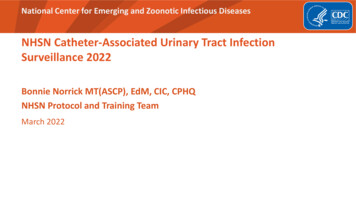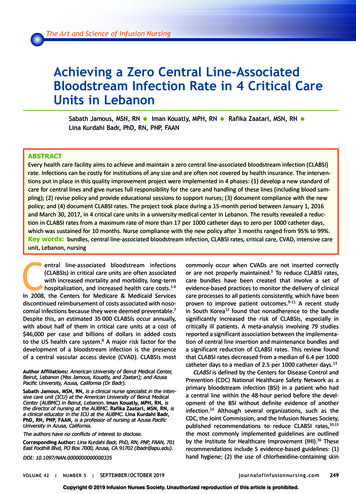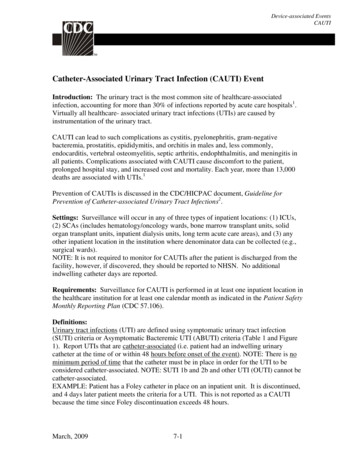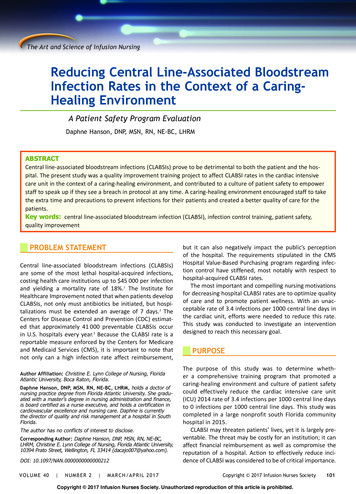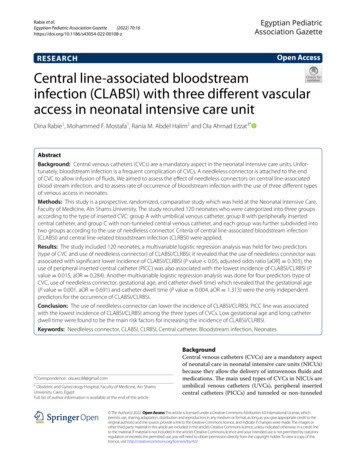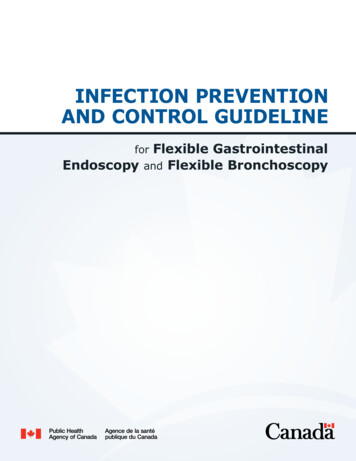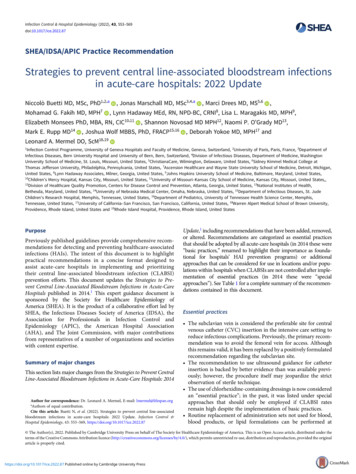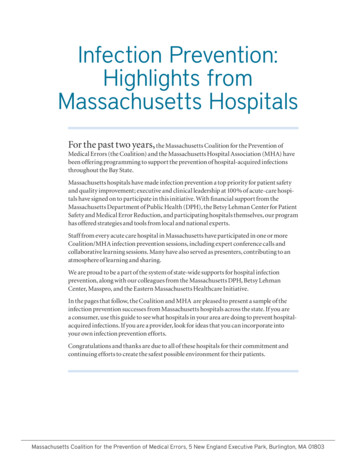
Transcription
Central Line-AssociatedBloodstream Infection (CLABSI):Central Venous CatheterAppropriateness1
PresenterPayal Patel, MD, MPHInfection Diseases Physician and Assistant ProfessorUniversity of MichiganMedical Director of Antimicrobial StewardshipAnn Arbor VA Healthcare SystemContributions byVineet Chopra, MD, MScUniversity of MichiganKristi Felix, RN, BSN, CRRN, CIC, FAPICMadonna Rehabilitation HospitalKaren Jones, RN, MPH, CICUniversity of MichiganLen Mermel, DO, ScM, AM (Hon)Medical School of Brown UniversityRuss Olmsted, MPH, CICTrinity Health, Livonia MI2
Learning Objectives Define central venous catheter (CVC)appropriateness Use clinical case studies to apply tools fordetermining CVC appropriateness Explain how an algorithm can be used when patientshave difficult venous access3
Appropriateness DefinitionA procedure is considered appropriate when thenet benefit is much greater than the net harm,regardless of costCVC appropriateness:When should a patient have a CVC placed?If the determination for CVC is made, what type of CVC is mostappropriate?How many lumens?What gauge?What anatomic site?(Fitch K, The RAND/UCLA Appropriateness Method User’s Manual, 2001)4
Common Indications for CVC and PeripherallyInserted Central Catheter (PICC) PlacementAdministration of vasopressors, chemotherapy or totalparenteral nutrition (TPN)Extended course of intravenous (IV) antibioticsSupport high-volume flow for therapy such as hemodialysisHemodynamic monitoring in critically ill patientsProvide venous access for placement of devices, such as cardiacpacemakerInadequate peripheral venous accessNeed for frequent blood draws(Lee-Llacer J, Lippincott Williams & Wilkins, 2012)5
Limitations of Static IndicationsDo not distinguish between types of CVCsRisk of complication varyInsertion versus downstream riskTypes of complication varyInfectious versus thromboticOperator skill varyAvailability of specific devices varyStatic recommendations do not account for duration ofuseDuration should influence CVC choice6
Michigan Appropriateness Guide forIntravenous Catheters7
Appropriateness Criteria for Use ofVenous Access DevicesThe Michigan Appropriateness Guide for Intravascular Catheters(MAGIC)Expert panel of 15Included vascular access nurses; physicians trained in internal medicine,infectious disease, critical care, nephrology, hematology/oncology,surgery and interventional radiology; and a pharmacist and patientpanelistRAND/UCLA Appropriateness Methodology677 scenarios involving use of 7 common venous access devicesDeveloped recommendations for when to use a PICC versusother venous access devices(Chopra V, Ann Intern Med, 2015)8
CVC TypesD.1 Non-Tunneled Central Venous CatheterA. Peripheral IV CatheterD.2 Tunneled Central Venous CatheterB. US-Guided Peripheral IV CatheterC. Midline CatheterPeripherally InsertedCentral Catheter (PICC)(Image Source. Chopra V, Ann Intern Med, 2015)9E. Implanted Port
Figure 1. Venous Access Device Appropriateness Ratings For Infusionof Peripherally-Compatible Therapies InGeneral Hospitalized Patients(Chopra V, Ann Intern Med, 2015)10
Figure 2. Venous Access Device Appropriateness Ratings forInfusion of Vesicants or Irritants (Non-chemotherapy) in GeneralHospitalized Patients(Chopra V, Ann Intern Med, 2015)11
Clinical Cases for CVC Appropriateness12
Case 1: Mr. MantegnaMr. Mantegna is a 68-year-old man who is admitted to theICU with streptococcal sepsis and respiratory failure. He isintubated and hypotensive. He now needs vasopressorsupport and invasive blood pressure monitoring.What type of access is most appropriate for this patient?a. Tunneled CVCb. Non-tunneled acute CVCc.PIVd. Ultrasound-guided peripheral catheterDisclaimer: All case studies are hypothetical and not based on any actual patient information. Any similaritybetween a case study and actual patient experience is purely coincidental.13
Figure 2. Venous Access Device AppropriatenessRatings For Infusion of Vesicants or Irritants(Chopra V, Ann Intern Med, 2015)14
Case 2: Ms. BondMs. Bond is a 49-year-old woman with worsening back pain. She isadmitted to the hospital and found to have MSSA vertebralosteomyelitis. ID is consulted and recommends a total of 6 weeks of IVcefazolin. She currently has only one peripheral IV catheter. She isready for discharge.What type of CVC will be best for her antibiotic course?a.Internal jugular CVCb.Peripheral IV catheterc.Subclavian CVCd.Midline cathetere.PICCDisclaimer: All case studies are hypothetical and not based on any actual patient information. Any similaritybetween a case study and actual patient experience is purely coincidental.15
Figure 1. Venous Access Device Appropriateness Ratings ForInfusion of Peripherally-Compatible Therapies InGeneral Hospitalized Patients16
Case 3: Mr. WattMr. Watt is a 78-year-old man admitted to the medical/surgicalward following a post-gastric bypass surgical incision dehiscence.Multiple attempts to obtain a peripheral IV by various staff havefailed. The nurse asks for a PICC placement.Is placement of a PICC appropriate in this setting?a.b.c.YesNoUnsureDisclaimer: All case studies are hypothetical and not based on any actual patient information. Any similaritybetween a case study and actual patient experience is purely coincidental.17
Difficult IV AccessPICC often used when peripheral IV cannot be placedSelection of a PICC should not occur withoutconsidering appropriateness of use, including:DurationInfusionPatient CharacteristicsAlternatives to PICCs should be consideredAn algorithm can be helpful18
Alternatives to PICC19
Other ConsiderationsLumensMore lumens is not betterAs number of lumens increase, so does gauge/thickness andrisk of thrombosisAs number of lumens increase, so does risk of infectionRemoval protocols may helpCVCs should be removed as soon as clinically reasonable tolimit risk of complications(Chopra V, Am J Med 2014; Chopra V, J Thromb Haemost, 2014; Evans RS, Chest, 2013; Shah H,Neurohospitalist, 2013)20
Limitations Each patient is different These are general approaches When choosing CVCs, consider site, lumens, andgauge to prevent harm Evidence base for CVC and PICC use is limited MAGIC provides input Recommendations primarily designed to guidePICC use, but applicable to CVC use in ICUsettings21
Take-Home Points Appropriateness of CVC depends on patient, deviceand provider characteristics The MAGIC Guide can help decide if a CVC isappropriate and which type of CVC is best Alternatives to CVCs include peripheral IV cathetersand midlines Remove CVCs as soon as possible22
ReferencesChopra V, Flanders SA, Saint S, et al. The Michigan AppropriatenessGuide for Intravenous Catheters (MAGIC): results from a multispecialtypanel using the RAND/UCLA appropriateness method. Ann Intern Med.2015; 163(6): S1-S40.Chopra V, Ratz D, Kuhn L, et al. Peripherally inserted central catheterrelated deep vein thrombosis: contemporary patterns and predictors. JThromb Haemost. 2014; 12(6): 847-54.Chopra V, Ratzz D, Kuhn L, et al. PICC-associated bloodstreaminfections: prevalence, patterns, and predictors. Am J Med. 2014;127(4): 319-28.Evans RS, Sharp JH, Linford LH, et al. Reduction of peripherally insertedcentral catheter-associated DVT. Chest. 2013; 143(3): 627-33.23
References (cont’d)Fitch K, Bernstein SJ, Aguilar MD, et al. The RAND/UCLAAppropriateness Method User’s Manual. RAND Corporation. 2001.Lee-Llacer J, Seneff MG. Chapter 2: Central Venous Catheters. Irwinand Rippe’s Intensive Care Medicine. 2012; 7: 16-33.Shah H, Bosch W, Thompson KM, et al. Intravascular catheter-relatedbloodstream infection. Neurohospitalist. 2013; 3(3): 144-51.Simonov M, Pittiruti M, Rickard CM, et al. Navigating venous access: aguide for hospitalists. J Hosp Med. 2015; 10(7): 471-8.24
Speaker Notes25
Speaker Notes: Slide 1This module, titled “Central Venous Catheter Appropriateness,”will review when central venous catheters are appropriate byreviewing existing guidelines on general indications and how tochoose the best central venous catheter for a patient if one isnecessary.26
Speaker Notes: Slide 2This module was developed by national infection preventionexperts devoted to improving patient safety and infectionprevention efforts.27
Speaker Notes: Slide 3This module will review when placing a central venouscatheter—a CVC—is appropriate. The clinical scenarios in thismodule will teach you to use this information and other tools,including an algorithm, to help you the next time you need tomake a decision about using a CVC.28
Speaker Notes: Slide 4Let’s start with some definitions.Appropriateness, in terms of medical procedures, is when thenet benefit of having a procedure outweighs the net harm.Specifically with placement of a CVC, indications for the CVCshould outweigh the harms that can be associated withplacement such as developing a CLABSI.Appropriateness also applies to the location of the CVC, lumensize and gauge size, which can all affect risk of developinginfection.29
Speaker Notes: Slide 5According to the literature, situations in which there is greaterbenefit than harm to placing a central line include: Administration of irritants such as vasopressors, chemo ortotal parenteral nutrition (TPN); Extended course of IV antibiotics Support of high-volume flow for therapy such ashemodialysis; Hemodynamic monitoring in critically ill patients; Providing venous access for placement of a device, such asa pacemaker; and Inadequate peripheral venous access.30
Speaker Notes: Slide 6Using these indications can be challenging because each patientis different, each hospital is different and operator skill ofhealthcare personnel placing the line can vary, so staticindications are not perfect. In addition, few recommendationshave taken into account duration of catheter use.31
Speaker Notes: Slide 7With these limitations in mind, a group of experts led by Dr.Vineet Chopra at the University of Michigan and Ann Arbor VAcame up with a new guideline called MAGIC—The MichiganAppropriateness Guide to Intravenous Catheters—to helpclinicians make a choice about what type of CVC to use.The next slides will go into the best way to use the MAGIC guidewithin your clinical practice. This is an excellent tool to use thenext time you have to make a decision about a non-emergentcentral line.32
Speaker Notes: Slide 8To develop these guidelines, fifteen experts were gathered tomake up an expert panel: this included vascular access nurses;physicians trained in internal medicine, infectious diseases,critical care, nephrology, hematology/oncology, surgery andinterventional radiology; as well as a pharmacist and patientpanelist. Using a methodology that helps guide decision makingin medicine called the RAND/UCLA Appropriatenessmethodology, they looked at 677 scenarios and agreement ofthe panel was tracked to help come up with the finalrecommendation.33
Speaker Notes: Slide 9The recommendations within this guideline are particularlyhelpful for when a PICC is indicated, but also include other CVCs,such as non-tunneled CVCs.This slide illustrates the catheters discussed within the guideline.Images A, B and C are not considered central lines, but can oftenbe used to avoid placing a central line if not indicated.Using a vein finder or ultrasound, a peripheral IV catheter isoften a good alternative when working with a patient who isdifficult to access. Midlines are also a good alternative to acentral line.34
Speaker Notes: Slide 10Here’s a helpful graphic from the MAGIC guide.As the title of the figure indicates, this is a useful graphic forpatients who need infusions, like antibiotics, that can be givenperipherally. Let’s say you are looking at a patient who will need12 more days of ceftriaxone. Go to the 6-14 days column. Theyellow box at peripheral IV (PIV) indicates this was notconsidered appropriate or inappropriate by the group of experts.However, ultrasound guided peripheral catheters, non-tunneledacute CVC such as an IJ (internal jugular) or subclavian would befine as well—but only if the patient is critically ill orhemodynamic monitoring is also needed. A midline seems to bebest and is preferred to PICC since we only need it for 12 days.35
Speaker Notes: Slide 11This is another helpful graphic from MAGIC. As the title suggests,this is aimed at patients who will be getting an irritating solutionthrough their IV, such as vancomycin.Let’s say you have a patient who is going to need three weeks ofvancomycin for a shoulder infection. We see right away that PIVs,ultrasound guided PIVs, non-tunneled acute CVCs and midlinesare considered inappropriate. Looking in the 15-30 days column,we see that a PICC line would be appropriate for this patient.36
Speaker Notes: Slide 12Next, we will use examples from the MAGIC guide to go througha formal clinical case.37
Speaker Notes: Slide 13Case 1: Mr. Mantegna is a 68-year-old man who is admitted tothe ICU with streptococcal sepsis and respiratory failure. He isintubated and hypotensive. He now needs vasopressor supportand invasive blood pressure monitoring.What type of access is most appropriate for this patient?a. Tunneled CVCb. Non-tunneled acute CVCc. PIVd. Ultrasound-guided peripheral catheter38
Speaker Notes: Slide 14You know from the case presentation that Mr. Mantegna isacutely sick. He’s in the ICU and not a general medical-surgicalpatient. He is also on vasopressors. Go to this table: the bestoption for him is a non-tunneled/acute central venous catheter.39
Speaker Notes: Slide 15Case 2: Ms. Bond is a 49-year-old woman with worsening backpain. She is admitted to the hospital in the medical/surgical wardand found to have methicillin sensitive Staph aureus, or MSSAvertebral osteomyelitis. Infectious diseases is consulted and theyrecommend a total of six weeks of IV cefazolin. She currently hasonly one peripheral IV catheter. She is ready for discharge. Whichtype of CVC will be best for her antibiotic course?The options are:a. Internal jugular CVCb.Peripheral IV catheterc. Subclavian CVCd.Midline cathetere. PICC40
Speaker Notes: Slide 16In this case, Ms. Bond is on the medical/surgical ward and ishemodynamically stable, but will need a long course ofantibiotics for her bone infection. The suggested antibiotic is notan irritant antibiotic and would be peripherally compatible so welook at this graphic.According to the graphic, Ms. Bond will need more than 31 daysof antibiotics. A PICC line is the preferred CVC for her.41
Speaker Notes: Slide 17Case 3: Mr. Watt is a 78-year-old man admitted to themedical/surgical ward following a post-gastric bypass surgicalincision dehiscence. Multiple attempts to obtain a PIV by variousstaff have failed. The nurse asks for a PICC placement.Is placement of a PICC appropriate in this setting?42
Speaker Notes: Slide 18The case presented here is a common scenario. PICC lines areoften used when a peripheral IV cannot be placed. Before goingstraight to a PICC line, which is a central line, the medical teamshould consider how long access will be needed, what the accessis for and patient characteristics.Alternatives to PICCs should be considered, if possible.An algorithm can be very helpful in decision making.43
Speaker Notes: Slide 19Often alternatives like a peripheral IV catheter placed with a veinfinder, ultrasound guided PIV or a midline may be a choice thatpresents less risk for the patient.Other central venous catheters that may be better could includea short-term CVC, or a tunneled catheter or port depending onthe treatment.44
Speaker Notes: Slide 20Another consideration before placing a central line is lumen size.Research has shown CLABSI risk increases with the number oflumens. As lumens increase, so does the gauge and thickness ofthe line and the risk of a thrombosis. In addition toappropriateness of central line placement, once it is placed,health care teams should be focused on when the central line isno longer needed and should promptly remove unnecessarylines to avoid infection.45
Speaker Notes: Slide 21Each patient is different, and these approaches should beunderstood as general guidance rather than the rule. Whenchoosing a CVC, always consider site, lumens and gauge size toprevent harm.Remember the evidence base for CVC and PICC use is limited,but the MAGIC guide can provide some input and may help youin decision making.46
Speaker Notes: Slide 22As you consider integrating interventions to include a review ofclinical indications and alternates to CVCs remember that: Appropriateness of CVC depends on patient, device and providercharacteristics; Using clinical approaches like the ones highlighted in this coursemay help you make the best choice; Alternative options to CVCs include PIVs with help of a veinfinder or ultrasound to guide placement and midlines; And most importantly, if a CVC needs to be placed, remember toremove it as soon as clinically possible to limit the risk ofcomplications.47
Speaker Notes: Slide 22 ContinuedWe know that approximately 23,500 CLABSI cases occur with anannual mortality rate from 12 to 25 percent. Avoiding placementof and removing a CVC when not indicated makes getting to zeroinfections more of a reality.48
Speaker Notes: Slide 23No notes.49
Speaker Notes: Slide 24No notes.50
2015; 163(6): S1-S40. Chopra V, Ratz D, Kuhn L, et al. Peripherally inserted central catheter-related deep vein thrombosis: contemporary patterns and predictors. J Thromb Haemost. 2014; 12(6): 847-54. Chopra V, Ratzz D, Kuhn L, et al. PICC-associated bloodstream
